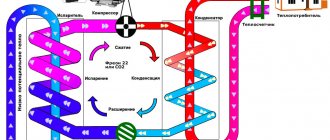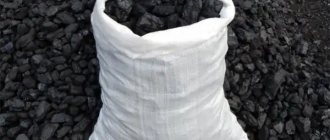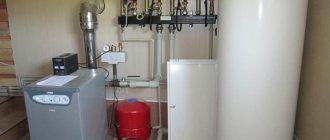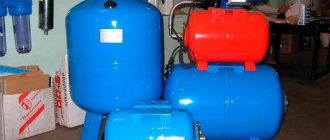The procedure for calculating heating in a residential building depends on the availability of metering devices and on the way in which the house is equipped with them. There are several options for equipping multi-apartment residential buildings with meters, and according to which thermal energy is calculated:
- the presence of a common building meter, while apartments and non-residential premises are not equipped with metering devices.
- Heating costs are controlled by a common house meter, and all or some rooms are equipped with metering devices.
- There is no general device for recording the consumption and consumption of thermal energy.
Before calculating the number of gigacalories spent, it is necessary to find out the presence or absence of controllers in the house and in each individual room, including non-residential ones. Let's consider all three options for calculating thermal energy, for each of which a specific formula has been developed (posted on the website of state authorized bodies).
Option 1
So, the house is equipped with a control device, but some rooms are left without it. Here it is necessary to take into account two positions: calculating Gcal for heating an apartment, the cost of thermal energy for general house needs (GCA).
In this case, formula No. 3 is used, which is based on the readings of the general metering device, the area of the house and the footage of the apartment.
Calculation example
Let's assume that the controller has recorded the house's heating costs at 300 Gcal/month (this information can be found from the receipt or by contacting the management company). For example, the total area of the house, which consists of the sum of the areas of all premises (residential and non-residential), is 8000 m² (you can also find out this figure from the receipt or from the management company).
Let’s take an apartment area of 70 m² (indicated in the registration certificate, rental agreement or registration certificate). The last figure on which the calculation of payment for consumed heat depends is the tariff established by the authorized bodies of the Russian Federation (indicated in the receipt or find out from the house management company). Today the heating tariff is 1,400 rubles/gcal.
Substituting the data into formula No. 3, we get the following result: 300 x 70 / 8,000 x 1,400 = 1,875 rubles.
Now you can move on to the second stage of accounting for heating costs spent on the general needs of the house. Here you will need two formulas: searching for the volume of service (No. 14) and payment for the consumption of gigacalories in rubles (No. 10).
To correctly determine the volume of heating in this case, you will need to sum up the area of all apartments and premises provided for common use (information is provided by the management company).
For example, we have a total area of 7000 m² (including apartments, offices, retail premises.).
Let's start calculating the payment for thermal energy consumption using formula No. 14: 300 x (1 – 7,000 / 8,000) x 70 / 7,000 = 0.375 Gcal.
Using formula No. 10, we get: 0.375 x 1,400 = 525, where:
- 0.375 – volume of service for heat supply;
- 1400 rub. – tariff;
- 525 rub. - amount of payment.
We sum up the results (1875 + 525) and find out that the payment for heat consumption will be 2350 rubles.
ANNUAL HEAT CONSUMPTION
To determine fuel consumption, develop equipment use modes, repair schedules, etc. it is necessary to know the annual heat consumption for heat supply, as well as its distribution by season (winter, summer) or by individual months. The annual heat consumption by consumers in the region is determined by the formula
,
where Qyear, Qyear, Qyear, Qthyear are the annual heat consumption for heating, ventilation, hot water supply, and technological needs.
Annual heat consumption for heating
where Qav
— average heat consumption during the heating period, J/s or kcal/h;
nо - duration of operation of the heating system, s/year or h/year; for residential and public buildings n0
is the duration of the heating period; nd — duration of operation of standby heating, s/year or h/year; tin.d — internal air temperature during standby heating operation, °C.
Average heat consumption for the heating period
For residential and public buildings Qо/= Q/, where Q' is the estimated heat loss of the building at outside temperature tno
.
For industrial buildings Q'о = Q'—Qт
in, where
Qtv
is internal heat generation;
tнср.о - the average temperature of the heating period for residential and public buildings, for industrial buildings tнср.о - the average temperature of the outside air during the heating period.
The annual heat consumption for ventilation is determined by the formula
where Qv/ is the estimated heat consumption for ventilation, J/s or kcal/h; pv
— duration of the heating period with outside air temperature
tн <
tнв, s/year or h/year (with tнв = tнв
=
0);
ndv - duration of the heating period when ventilation does not work, s/year or h/year; tнср.в - average outside air temperature for the period from the beginning of the heating period tH=
tн.к to tн=tн.в.
Annual heat consumption for hot water supply
where Qгср.н
— average weekly heat consumption for hot water supply, J/s or kcal/h;
pg n0
- duration of operation of the hot water supply system and duration of the heating period, s/year/hour/year; b—coefficient taking into account the change in the average weekly water consumption for hot water supply during the non-heating period in relation to the heating period; in the absence of more accurate data, it is recommended to accept: b = 0.8 for the housing and communal services sector of all areas, except for resort and southern cities; b = 1.5 for the housing and communal services sector of resort and southern cities; b= 1 for industrial enterprises.
The annual heat consumption for technological needs is determined on the basis of the annual heat consumption schedule. An approximate graph of heat consumption by month is shown in Fig. 3.
Rice. 3. Approximate graph of heat consumption by month of the year
Heat load duration chart
To establish an economical mode of operation of heating equipment and select the most optimal parameters of the coolant, it is necessary to know the duration of operation of the heat supply system under various modes throughout the year. For this purpose, graphs of the duration of the thermal load are constructed (Rossander graphs).
The method for plotting the duration of seasonal heat load is shown in Fig. 4. Construction is carried out in four quadrants. In the upper left quadrant, graphs are plotted depending on the outside temperature tH,
heating load
Q0,
ventilation
QB
and total seasonal load
(Q0 +
<2).
The lower left quadrant shows the curve of the duration of standing n
during the heating period of external temperatures tn equal to a given temperature or lower.
In the lower right quadrant, a straight line is drawn at an angle of 45° to the vertical and horizontal axes, used to transfer scale values .
from the lower left quadrant to the upper right quadrant.
The graph of the duration of the thermal load 5 is constructed for different external temperatures tн
at the points of intersection of the dashed lines that determine the thermal load and the duration of standing loads equal to or greater than this.
Area under the curve 5
The duration of the heat load is equal to the heat consumption for heating and ventilation during the heating season Qyear.
Rice. 4. Plotting the duration of seasonal heat load
In the case when the heating or ventilation load changes by hour of the day or day of the week, for example, when during non-working hours industrial enterprises are switched to standby heating or the ventilation of industrial enterprises does not operate around the clock, three heat consumption curves are plotted on the graph: one (usually a solid line) based on the average heat consumption per week for heating and ventilation at a given outside temperature; two (usually a dotted line) based on the maximum and minimum heating and ventilation loads at the same outside temperature tH.
This construction is shown in Fig. 5.
Rice. 5. Integral graph of the total load of the area
A
—
Q
= f(tн);
b
- graph of the duration of the thermal load;
1 — weekly average hourly load; 2
— maximum hourly total load;
3
- minimum hourly total load
The annual heat consumption for heating can be calculated with a small error without accurately taking into account the frequency of external air temperatures during the heating season, taking the average heat consumption for heating for the season equal to 50% of the heat consumption for heating at the calculated external temperature tno.
If the annual heat consumption for heating is known, then, knowing the duration of the heating season, it is easy to determine the average heat consumption. For approximate calculations, the maximum heat consumption for heating can be taken equal to twice the average consumption.
Option 2
Now we will calculate payments in conditions where the house is equipped with a common heating meter, and some of the apartments are also equipped with individual meters. As in the previous case, the calculation will be carried out according to two positions (thermal energy consumption for housing and ODN).
We will need formula No. 1 and No. 2 (accrual rules according to controller readings or taking into account heat consumption standards for residential premises in Gcal). Calculations will be carried out relative to the area of the residential building and apartment from the previous version.
Calculation 1
Formula No. 1: 1.3 x 1,400 = 1,820 rubles, where:
- 1.3 gigacalories – individual meter readings;
- RUR 1,1820 – approved tariff.
Formula No. 2: 0.025 x 70 x 1,400 = 2,450 rubles, where:
- 0.025 Gcal – standard indicator of heat consumption per 1 m² of area in an apartment;
- 70 m² – square footage of the apartment;
- 1,400 rub. – tariff for thermal energy.
As it becomes clear, with this option, the payment amount will depend on the availability of a metering device in your apartment.
Next, we calculate the second component of our payment (ODN) using two formulas - No. 13 (volume of service) and No. 10 (heating cost).
Calculation 2
Formula No. 13: (300 – 12 – 7,000 x 0.025 – 9 – 30) x 75 / 8,000 = 1.425 gcal, where:
- 300 gcal – readings of the common house meter;
- 12 Gcal – the amount of thermal energy used to heat non-residential premises;
- 6,000 m² – the sum of the area of all residential premises;
- 0.025 – standard (heat energy consumption for apartments);
- 9 Gcal – the sum of indicators from the meters of all apartments that are equipped with metering devices;
- 35 Gcal – the amount of heat spent on supplying hot water in the absence of a centralized supply;
- 70 m² – apartment area;
- 8,000 m² – total area (all residential and non-residential premises in the house).
Please note that this option includes only the actual volumes of energy consumed and if your house is equipped with a centralized hot water supply, then the amount of heat spent on hot water supply needs is not taken into account. The same applies to non-residential premises: if they are not in the house, then they will not be included in the calculation.
Next comes the calculation of the payment for heating by multiplying the volume of heat by the tariff according to formula No. 10: 1.425 x 1,400 = 1,995 rubles, where:
- 1.425 gcal – amount of heat (AT);
- 1,400 rub. – approved tariff.
As a result of the calculations, we found out that the full payment for heating will be:
- 1820 + 1995 = 3,815 rubles. - with an individual counter.
- 2,450 + 1995 = 4,445 rubles. - without an individual device.
Option 3
We have one last option left, during which we will consider the situation when the house does not have a heat meter. The calculation, as in previous cases, will be carried out according to two categories (thermal energy consumption per apartment and ADN).
We will calculate the amount for heating using formulas No. 1 and No. 2 (rules on the procedure for calculating thermal energy, taking into account the readings of individual metering devices or according to established standards for residential premises in Gcal).
Calculation 1
Formula No. 1: 1.3 x 1,400 = 1,820 rubles, where:
- 1.3 Gcal – individual meter readings;
- 1,400 rub. – approved tariff.
Formula No. 2: 0.025 x 70 x 1,400 = 2,450 rubles, where:
- 0.025 Gcal – standard indicator of heat consumption per 1 m² of living space;
- 70 m² – total area of the apartment;
- 1,400 rub. – approved tariff.
As in the second option, the payment will depend on whether your home is equipped with an individual heat meter. Now it is necessary to find out the amount of heat energy that was spent on general house needs, and this must be done according to formula No. 15 (volume of services for one-room service) and No. 10 (amount for heating).
Easy ways to calculate heat load
Any calculation of the thermal load is needed to optimize the parameters of the heating system or improve the thermal insulation characteristics of the house. After its implementation, certain methods of regulating the heating heat load are selected. Let's consider non-labor-intensive methods for calculating this parameter of the heating system.
Dependence of heating power on area
Table of correction factors for various climatic zones of Russia
For a house with standard room sizes, ceiling heights and good thermal insulation, you can apply a known ratio of room area to the required thermal power. In this case, 1 kW of heat will need to be generated per 10 m². A correction factor must be applied to the result obtained, depending on the climate zone.
Let's assume that the house is located in the Moscow region. Its total area is 150 m². In this case, the hourly heating load will be equal to:
15*1=15 kW/hour
The main disadvantage of this method is the large error. The calculation does not take into account changes in weather factors, as well as the features of the building - the heat transfer resistance of walls and windows. Therefore, in practice it is not recommended to use it.
Integrated calculation of the thermal load of a building
A larger calculation of the heating load is characterized by more accurate results. Initially, it was used for preliminary calculation of this parameter when it was impossible to determine the exact characteristics of the building. The general formula for determining the heating load is presented below:
Where q° is the specific thermal characteristic of the structure. The values must be taken from the corresponding table, a is the correction factor mentioned above, Vn is the external volume of the building, m³, Tin and Tnro are the temperature values inside the house and outside.
Table of specific thermal characteristics of buildings
Let's assume that it is necessary to calculate the maximum hourly heating load in a house with a volume along the external walls of 480 m³ (area 160 m², two-story house). In this case, the thermal characteristic will be equal to 0.49 W/m³*C. Correction factor a = 1 (for the Moscow region). The optimal temperature inside the living space (Tvn) should be +22°C. The outside temperature will be -15°C. Let's use the formula to calculate the hourly heating load:
Q=0.49*1*480(22+15)= 9.408 kW
Compared to the previous calculation, the resulting value is smaller. However, it takes into account important factors - temperature indoors, outdoors, and the total volume of the building. Similar calculations can be made for each room. The method for calculating the heating load using aggregate indicators makes it possible to determine the optimal power for each radiator in a separate room. For a more accurate calculation, you need to know the average temperature values for a specific region.
This calculation method can be used to calculate the hourly heat load for heating. But the results obtained will not provide an optimally accurate value of the building’s heat losses.











